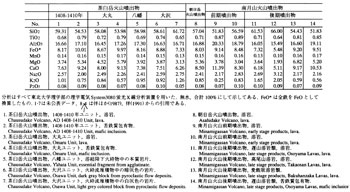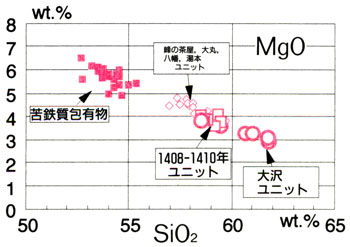Nasu Volcano
Introduction / Geology of Nasu volcano and environs / Outline of Nasu volcano
Rocks of Nasu Volcano
Eruptive history and mode of eruption of Chausudake Volcano
Eruptions of 1408 - 1410 / Eruptions of recent times
Surveillance of volcanic activities / Prediction of future activities
Acknowledgments / References
![]() PREV
PREV ![]() NEXT
NEXT
Rocks of Nasu Volcano
Rocks of NVG are variable; basalt to andesite of tholeiite rock series and andesite to dacite of calcalkalic rock series. In Kasshi-Asahidake, Sanbonyaridake, and Minami-Gassan Volcanoes, rocks belonging to both tholeiitic and calcalkalic rock series are distributed. Those of tholeiitic series were active in early stage while those of calcalkalic series in late stage in general. In Asahidake and Chausudake Volcanoes occur only rocks of calcalkalic rock series. Comparing at the same SiO2 contents, those belonging to tholeiitic rock series tend to show higher concentrations of TiO2,Al2O3,FeO*,and MnO and lower K2O and MgO than those of calcalkalic rock series ( ![]() Table 1 ).
Table 1 ).
Basalts of tholeiitic rock series are dark grey and compact with phenocrysts of plagioclase, olivine, orthopyroxene, and clinopyroxene. Andesites are gray to bluish grey and compact with phenocrysts of plagioclase, orthopyroxene, clinopyroxene, and iron ores. Olivine phenocrysts are surrounded by pigeonite rim. Groundmass is mainly plagioclase, augite, and pigeonite with minor iron ore, silica minerals, and volcanic glass.
In calcalkalic rock series, andesites tend to be grey while dacites bluish grey with phenocrysts of plagioclase, orthopyroxene, clinopyroxene, iron ores and occasionally olivine or quartz. Very rarely common hornblende occurs as phenocrysts. Olivine and orthopyroxene phenocrysts don't have reaction rims of other minerals. In many andesites and in some dacites, textures suggesting mixing of multiple magmas are prevalent. They include; pyroxene phenocrysts contain glass and other foreign materials: many orthopyroxene phenocrysts tend to show reverse growth zoning: plagioclase phenocrysts show mixed occurrences of clear ones with those containing glass and other foreign materials, and perforated crystals: many quartz phenocrysts are corroded and not showing crystal outlines. Groundmass consists mainly of plagioclase, augite, and orthopyroxene with minor iron ores, silica minerals, and volcanic glass.
In many rocks of calcalkalic rock series, accidental materials different from country rocks such as mafic inclusions are contained. The inclusions are in variable shapes of ball to irregular and they are mostly less than 20 cm across. Their color ranges from whitish grey to grey with little vesiculation. The phenocrysts are plagioclase, olivine, orthopyroxene, and clinopyroxene with groundmass of acicular plagioclase, orthopyroxene, clinopyroxene, and glass. The SiO2 concentrations of mafic inclusions of Chausudake ejecta range from 52.5 to 55.5 wt% ( ![]() Fig. 2 ). Those are widely included in many lavas but in some cases inclusions themselves may be ejected as independent fragments.
Fig. 2 ). Those are widely included in many lavas but in some cases inclusions themselves may be ejected as independent fragments.
When rocks of both tholeiitic and calcalkalic rock series occur together as in Kasshi-Asahidake, Sanbonyaridake, and Minami-Gassan, Rb/Y ratios compared at the same value of Fe/Mg are different in many cases depending on the different rock series they belong to. This indicates that the parental magma was different between them. When calcalkalic series of rocks occur only as in Chausudake and Asahidake Volcanoes, the diagram for relationships between Rb / Y and Fe / Mg shows similar trend of nearby volcano in which both rock series occur together ( ![]() Fig. 3 ). Therefore, the rocks of Chausudake were interpreted to have formed by mixing of several different magmas.
Fig. 3 ). Therefore, the rocks of Chausudake were interpreted to have formed by mixing of several different magmas.
 ZOOM
ZOOM 
